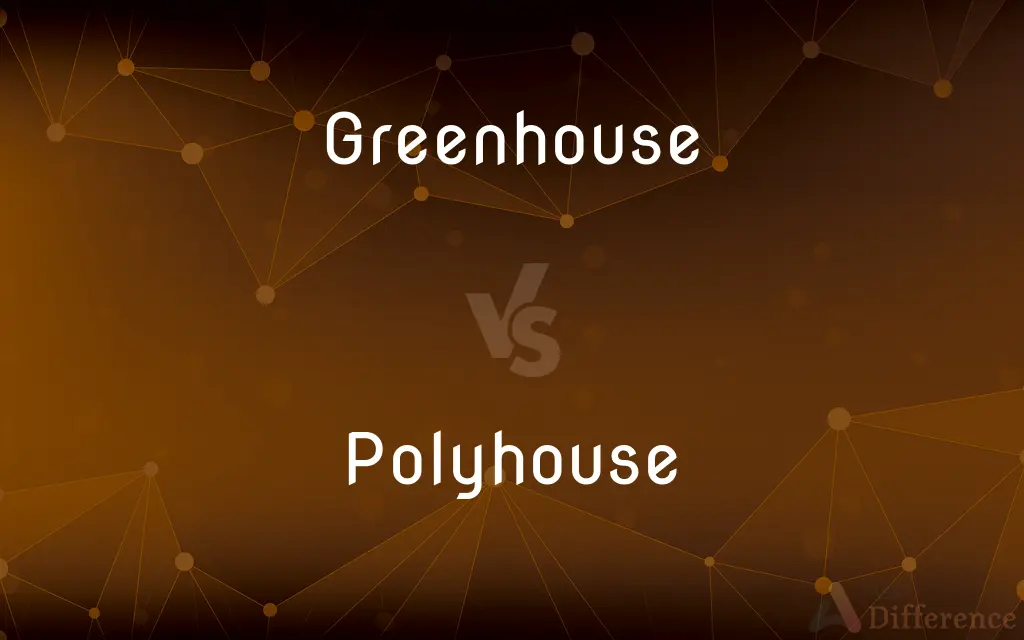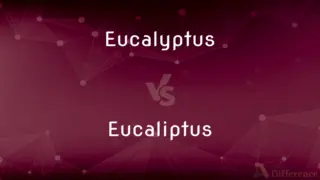Greenhouse vs. Polyhouse — What's the Difference?
By Maham Liaqat & Urooj Arif — Updated on March 18, 2024
A greenhouse is a structure with walls and a roof made primarily of transparent material, such as glass, for growing plants under controlled conditions, whereas polyhouse is a type of greenhouse covered with a layer of polyethylene or other plastic mate.

Difference Between Greenhouse and Polyhouse
Table of Contents
ADVERTISEMENT
Key Differences
Greenhouses have been used for centuries to cultivate plants in climates that are otherwise inhospitable to their growth. They work by allowing sunlight to enter and warm the interior while protecting plants from extreme weather, pests, and diseases. On the other hand, polyhouses are a modern innovation that uses polyethylene covering to achieve similar goals but with certain advantages like lower cost and improved control over internal conditions such as humidity, temperature, and light intensity.
The structural material is a key difference between these two. Traditional greenhouses use glass or fiberglass, which can be expensive and fragile but offers excellent clarity for sunlight penetration. Polyhouses, however, utilize a plastic film which is cheaper, flexible, and easier to replace. This material can diffuse light more evenly, which helps to reduce plant stress and promote uniform growth, but it may need to be replaced every few years due to wear and tear or degradation from UV exposure.
When it comes to the control of environmental conditions, both greenhouses and polyhouses can be equipped with systems to regulate temperature, humidity, and ventilation. However, polyhouses often incorporate advanced technologies more readily, such as automated misting systems, shade cloths, and energy-efficient heating systems, due to their modern design and the adaptability of plastic materials to these technologies.
In terms of cost, constructing a greenhouse can be more expensive initially due to the cost of glass and the need for a durable frame to support it. Polyhouses, with their lighter weight and less expensive materials, offer a more cost-effective solution for many farmers, particularly those in developing countries or with limited budgets. The trade-off comes in longevity and maintenance; glass greenhouses can last many years with minimal maintenance, while polyhouses might require more frequent attention and replacement of the plastic covering.
The choice between a greenhouse and a polyhouse often depends on the specific needs of the grower, including budget, crop types, local climate conditions, and desired level of environmental control. While both structures aim to extend the growing season and protect plants from adverse weather, pests, and diseases, each has its own set of advantages and challenges.
ADVERTISEMENT
Comparison Chart
Covering Material
Glass, fiberglass
Polyethylene or other plastic films
Light Penetration
High clarity for sunlight
Diffuses light more evenly
Environmental Control
Can be equipped with control systems
Often incorporates more advanced technology
Cost
Higher initial investment
More cost-effective, cheaper materials
Durability
Long-lasting with minimal maintenance
Plastic covering may need replacement every few years
Compare with Definitions
Greenhouse
Often a significant investment but pays off in plant protection and yield.
The investment in the greenhouse was worth it for the increased tomato yield.
Polyhouse
The plastic covering needs to be replaced periodically.
After three years, the polyhouse covering was replaced to ensure optimal light transmission.
Greenhouse
Used to extend growing seasons in cooler climates.
Farmers use greenhouses to grow vegetables year-round despite the snow.
Polyhouse
A type of greenhouse with a plastic film covering.
The polyhouse uses a UV-resistant plastic to protect the plants.
Greenhouse
Requires maintenance, particularly in regulating temperature.
Ventilation systems in greenhouses help prevent overheating in summer.
Polyhouse
Ideal for high-value crops requiring precise climate control.
Polyhouses are perfect for growing exotic flowers for the market.
Greenhouse
A structure with glass walls and roof for growing plants in controlled conditions.
The botanical garden's greenhouse contains a rare orchid collection.
Polyhouse
More affordable and easier to construct than traditional greenhouses.
Small-scale farmers prefer polyhouses due to their low cost.
Greenhouse
Can be large or small, commercial, or for personal use.
She has a small greenhouse in her backyard for herbs and flowers.
Polyhouse
Can incorporate modern agricultural technologies.
The polyhouse features an automated irrigation system for efficient water use.
Greenhouse
A greenhouse (also called a glasshouse, or, if with sufficient heating, a hothouse) is a structure with walls and roof made chiefly of transparent material, such as glass, in which plants requiring regulated climatic conditions are grown. These structures range in size from small sheds to industrial-sized buildings.
Polyhouse
A polytunnel; a greenhouse or tunnel made of polyethylene, used to grow plants that require a higher temperature and/or humidity.
Greenhouse
A glass building in which plants that need protection from cold weather are grown.
Greenhouse
A structure, primarily of glass or sheets of clear plastic, in which temperature and humidity can be controlled for the cultivation or protection of plants.
Greenhouse
(Slang) A clear plastic bubble or shell covering part of an aircraft.
Greenhouse
A building used to grow plants, particularly one with large glass windows or plastic sheeting to trap heat from sunlight even in intemperate seasons or climates.
Greenhouse
The glass of a plane's cockpit.
Greenhouse
(medicine) A structure that shields the operating table to protect against bacteria.
Greenhouse
(climatology) A hot state in global climate.
Greenhouse
(transitive) To place (plants) in a greenhouse.
Greenhouse
To nurture in order to promote growth.
Greenhouse
A house in which tender plants are cultivated and sheltered from the weather.
Greenhouse
A building with glass walls and roof; for the cultivation and exhibition of plants under controlled conditions
Greenhouse
Of or relating to or caused by the greenhouse effect;
Greehouse gases
Common Curiosities
What is the main advantage of a polyhouse over a traditional greenhouse?
The main advantage of a polyhouse is its cost-effectiveness and the ability to more precisely control environmental conditions, benefiting from modern agricultural technologies.
Which is better for organic farming, a greenhouse or a polyhouse?
Both can be used for organic farming; the choice depends on specific needs like budget, crop types, and desired level of environmental control.
Can a greenhouse be converted into a polyhouse?
Yes, a greenhouse can be converted into a polyhouse by replacing the glass or fiberglass panels with a suitable plastic film, though this may require structural adjustments.
Are greenhouses and polyhouses only used for commercial farming?
No, greenhouses and polyhouses can be used for both commercial farming and personal gardening, varying in size and complexity according to the user’s needs.
How do weather conditions affect the choice between a greenhouse and a polyhouse?
The choice can depend on local weather conditions; for example, in areas with high wind speeds or heavy snowfall, a more durable and robust greenhouse might be preferable. In milder climates, a polyhouse could offer a more cost-effective solution while still providing adequate protection and environmental control.
What crops are best suited for polyhouse farming?
High-value crops like exotic flowers, vegetables, and certain fruits that require specific climatic conditions are well-suited for polyhouse farming, as it allows for more precise control over the environment.
Can greenhouses protect plants from all types of pests?
Greenhouses can significantly reduce the exposure of plants to pests but may not protect against all types. Integrated pest management practices are necessary for both greenhouse and polyhouse environments to control pest populations.
How often does the plastic covering of a polyhouse need to be replaced?
The plastic covering of a polyhouse typically needs to be replaced every 2 to 5 years, depending on the material's quality and environmental conditions.
Do greenhouses and polyhouses require similar maintenance?
While both require maintenance, polyhouses may need more frequent attention due to the durability of the plastic covering, whereas greenhouses, particularly those made with glass, often require less frequent but more specialized maintenance.
Is it more energy-efficient to use a greenhouse or a polyhouse?
Polyhouses can be more energy-efficient, especially when equipped with modern technologies for heating, cooling, and lighting, due to their ability to retain heat and more effectively manage internal conditions.
Share Your Discovery

Previous Comparison
Eucalyptus vs. Eucaliptus
Next Comparison
Duff vs. TailAuthor Spotlight
Written by
Maham LiaqatCo-written by
Urooj ArifUrooj is a skilled content writer at Ask Difference, known for her exceptional ability to simplify complex topics into engaging and informative content. With a passion for research and a flair for clear, concise writing, she consistently delivers articles that resonate with our diverse audience.















































